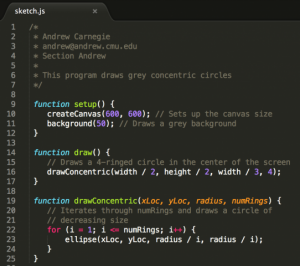A great programmer makes their code clear, robust, efficient, and user-friendly.
Code needs to be clear so others can read and understand your code.
Code needs to be robust* to reduce the number of errors in your program.
Code needs to be efficient to reduce the cost of your code.
Code needs to be user-friendly so that people will want to use your program.
Here are some Do’s and Don’ts that will guide you to becoming a better programmer. Bad style will cost your grade so keep these in mind and think of your own as well.
DO:
- Comment your code concisely
- Give your variables and functions good names for clarity
- End your phrases with semi-colons
- Indent your code properly
- Include your name, andrew ID, and section on the top of your code
DON’T:
- Have more than 80 characters in a line.
- Have dead code (code that does nothing, or commented out code)
- Use meaningless variable names
- Use magic numbers (numbers that come out of nowhere)
- Add too many comments, or redundant comments.
Here is a comparison of good and terrible code. If you can’t differentiate the two, ask for assistance as soon as possible.


*“Robust” is a great adjective that, when talking about software, has a fairly specific and technical meaning. Robust software is software that works without depending on many assumptions or conditions. A program that crashes when an expected file is not found is not robust. A program that reports the missing file, prompts the user to find the file, or presses on using reasonable default values is more robust.
![[OLD FALL 2017] 15-104 • Introduction to Computing for Creative Practice](https://courses.ideate.cmu.edu/15-104/f2017/wp-content/uploads/2020/08/stop-banner.png)